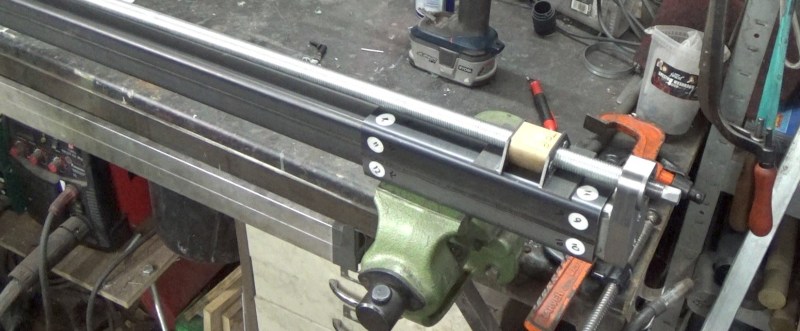The rise of cost-effective CNC platforms like 3D printers, routers, and laser cutters has gone hand in hand with the availability of affordable and accurate linear rails and extrusions. However, they quickly become expensive when you need something for heavy loads. [Andy Pugh] found himself in need of a large linear slide, so he resorted to making his own with steel square tubing and a bit of PTFE (Teflon).

[Andy] needed a compact motorcycle lift for his small workshop, so he designed one with a single vertical tube that mounts on his floor. The moving part of the lift is a slightly larger tube, onto which the motorcycle mounts. To allow the outer part to slide easily [Andy] machined a set of 16 PTFE spacers to fit between the surfaces of the tubes. The spacers have a small shoulder that lets them mount securely in the outer tube without pushing out. After a bit of fine-tuning with a file, it slides smoothly enough for [Andy]’s purposes. With a large lead screw mounted onto the lift, he can easily lift his 200 kg motorcycle with a cordless drill, without taking up all the floor space required by a traditional motorcycle lift.
Although the Teflon spacers will wear with regular use and, they are more than good enough for the occasional motorcycle service, and are also easy to replace. You may not want to use this on your next CNC machine build, but it is a handy blueprint to keep in your mental toolbox for certain use-cases. These spacers were machined on a lathe, but we found that very similar looking PTFE parts are sold as “wrist pin buttons” for the piston of old air cooled VW engines, and could be modified for the purpose.
For other lifting applications, check out this hydraulic workbench, and this forklift for moving stuff in your crawl space without crawling.
















200kg is not a lot. Cheap MGN-15H can easily support that.
@Cyna
PTFE on greased surfaces will tolerate a lot of of situations where temperatures are minimal, and will not bind up if a bit of grit gets dragged through the mechanism. However, pure non-recycled PTFE (i.e. less brittle) parts can be cost prohibitive in many situations. This is why most people prefer Delrin (acetal) based options when they don’t need the full chemical exposure resilience, and want a material much more forgiving to mill.
Ended up with a 2m by 1m sheet of 1mm thick PTFE. Also used it to make a linear slide – though the type where a toddler whizzes down it.
The grand plan for the scrounged offcut was to make runners for a sledge. Not happened yet, but moving to Finland where there’s more snow than many other places – so may get the project back off the back burner.
Welcome! Hopefully you get to the more northern parts of Finland, the coast is terrible snow-wise.
Better yet, Delrin AF (Anti-Friction). With particles or strands of PTFE in it.
Loves hard steel.
And, the Static friction is less than the Dynamic friction, for low or no Slip-Stick.
It’s quite a high moment load, the weight of the bike isn’t supported particularly efficiently by the bearing by the nature of the design.
I can’t help but mourn the lost art of pouring Babbit.
Or even Moglice.
Babbitt, that is. Where’s the edit button again?
Soon™
Babbitt alloy is still available from these guys if you are in the US or Canada:
http://www.rotometals.com
Casting is a good skill to learn of you have old machinery around.
;-)
Available at McMaster too. Limited alloys, and the usual double the price.
Not sure where my Dad got the stuff back then (way pre-internet, heck we still had party lines). It just showed up when needed.
Mourn no more. I also look after a 1916 Dennis fire engine and have poured new big-end bearings for that in the past.
The main drivers here were “quick” and “cheap”, though.
Is the Dennis what you were working on with that amazing setup where you had the cnc mill moving on a skew axis so you could mill threads at an odd angle?
No, that was a part from a small twin cylinder Renault. The fire engine has a 9 litre 4-cylinder so that exhaust manifold would hardly fit on my mill.
You have some cool cars to maintain. I sure did enjoy watching that setup and process.
I wouldn’t call it a lost art. But its certainly rarer than it was as Delrin etc is so quick and easy.
I wouldn’t have considered that sort of bearing for this project…
Countertop laminate with molybdenum disulphide dry lube makes fine (and cheap) bearing surfaces for steel, instead of that soft and expensive Teflon.
At age, I realize that I’m never going to even start on a large CNC machine. I have three 2″ diameter Thompson shafts 11 feet long with linear bearings and covers. Also a couple of 1.5″ shafts, same with bearings. Any interest – cheap? Located in Southern New Hampshire.
I’m in Central MA and if I had time to put them to use I’d be all over it. Unfortunately work is crazy busy and there’s 5 kids at home so free time for that kinda project is pretty much nil unfortunately.
With 5 kids you have a pretty good chance that one of them will be interested in being a shop helper.
That’s what happened with my dad.
As a bonus I was introduced to the fine art of swearing. Proven very useful at times.
Hi, we are producing 60 ton wind Gear box which should be moved by linear bearing for 20metre. Is it possible ?